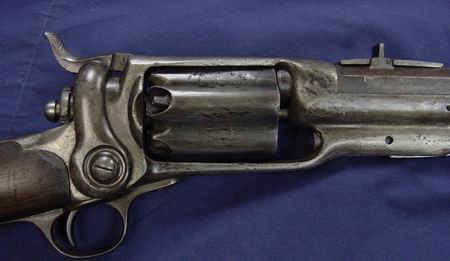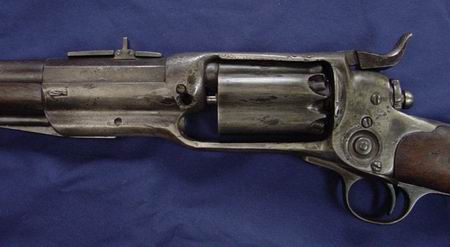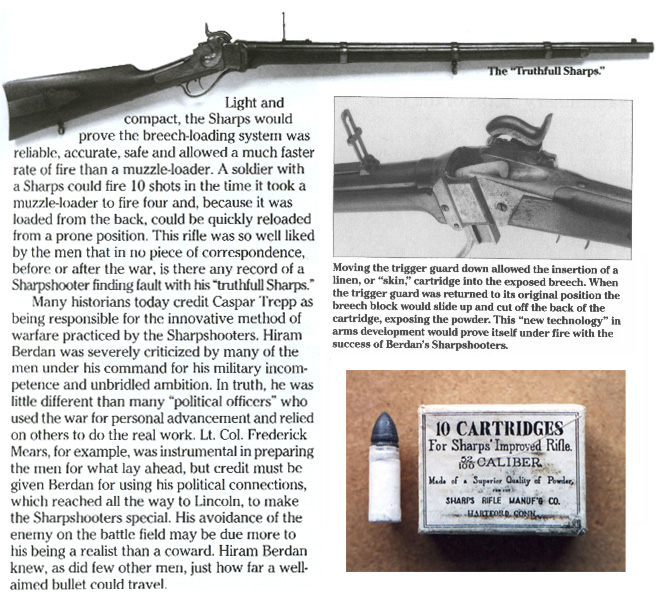 During the Civil War there were two green-uniformed regiments in Federal service. These were the First and Second Regiments of United States Sharpshooters, celebrated units in their time, though almost completely forgotten today. At the beginning of the war Hiram Berdan of New York, an engineer and noted marksman, proposed an organization of the best marksmen in the North. They were to be armed with the most reliable rifle then made and to be employed as sharpshooters and skirmishers. The Secretary of War accepted this idea, commisioning Berdan a Colonel of Volunteers and authorizing him to set up his own specifications as to personnel, weapons, uniform and equipment. Circulars were issued calling for the formation of campanies of sharpshooters. Each Applicant had to pass a shooting test, no men were to be enlisted who could not put ten bullets in succession within a ten inch (10") circle at 200 yards at a rest and 100 yards off hand. The First Regiment had the regulation ten companies: four from New York; three from Michigan; one each from Vermont, New Hampshire and Wisconsin. The Second Regiment never had more than eight companies, two each from New Hampshire and Vermont; one each from Minnesota, Michigan, Pennsylvania and Maine. At their ‘Camp of Instruction” on the North side of Washington, the sharpshooters’ training seems to have been practical and rough, teaching them never to expose themselves recklessly, to take all possible cover, and to waste no ammunition for the sake of shooting. All orders were given by bugle call, in imitation of European light troops. They remained in this camp from Sept. 1861 to March 1862. During the Civil War there were two green-uniformed regiments in Federal service. These were the First and Second Regiments of United States Sharpshooters, celebrated units in their time, though almost completely forgotten today. At the beginning of the war Hiram Berdan of New York, an engineer and noted marksman, proposed an organization of the best marksmen in the North. They were to be armed with the most reliable rifle then made and to be employed as sharpshooters and skirmishers. The Secretary of War accepted this idea, commisioning Berdan a Colonel of Volunteers and authorizing him to set up his own specifications as to personnel, weapons, uniform and equipment. Circulars were issued calling for the formation of campanies of sharpshooters. Each Applicant had to pass a shooting test, no men were to be enlisted who could not put ten bullets in succession within a ten inch (10") circle at 200 yards at a rest and 100 yards off hand. The First Regiment had the regulation ten companies: four from New York; three from Michigan; one each from Vermont, New Hampshire and Wisconsin. The Second Regiment never had more than eight companies, two each from New Hampshire and Vermont; one each from Minnesota, Michigan, Pennsylvania and Maine. At their ‘Camp of Instruction” on the North side of Washington, the sharpshooters’ training seems to have been practical and rough, teaching them never to expose themselves recklessly, to take all possible cover, and to waste no ammunition for the sake of shooting. All orders were given by bugle call, in imitation of European light troops. They remained in this camp from Sept. 1861 to March 1862.
 The original recruits were told to bring their own target rifles, if they wished, with the promise that the government would pay sixty dollars ($60) for every suitable weapon (a promise that was never kept). In the early days of the nation, target shooting was almost exclusively for hunting training. With the demands of colonial and frontier life, there was little time for the average person to shoot without an apparent purpose. "Shooting at the mark", which was a charred board with a piece of white paper fastened in the middle, was used initially to train people to shoot. Of course, the competitive nature comes out and people were soon doing "turkey shoots" or even "beef shoots". Somewhere between 1790 and 1800, the "match rifle" or "turkey rifle" was produced, with a heavy, full octagon barrel between 38" and 40" long, full stocked, double set triggers and a "tube sight". A tube sight is simply a tube with cross hairs mounted in it, with no lenses. With most target sights, such as the "globe sight", the object is to keep shadows and glare off the sights to aid the shooter. The rifling twist was slow, probably between 1:60 and 1:70, as it shot a linen-patched round ball. This seems to be the best spin for a round ball. The primer cap made its debut around 1815, which made things easier for the shooter. The original recruits were told to bring their own target rifles, if they wished, with the promise that the government would pay sixty dollars ($60) for every suitable weapon (a promise that was never kept). In the early days of the nation, target shooting was almost exclusively for hunting training. With the demands of colonial and frontier life, there was little time for the average person to shoot without an apparent purpose. "Shooting at the mark", which was a charred board with a piece of white paper fastened in the middle, was used initially to train people to shoot. Of course, the competitive nature comes out and people were soon doing "turkey shoots" or even "beef shoots". Somewhere between 1790 and 1800, the "match rifle" or "turkey rifle" was produced, with a heavy, full octagon barrel between 38" and 40" long, full stocked, double set triggers and a "tube sight". A tube sight is simply a tube with cross hairs mounted in it, with no lenses. With most target sights, such as the "globe sight", the object is to keep shadows and glare off the sights to aid the shooter. The rifling twist was slow, probably between 1:60 and 1:70, as it shot a linen-patched round ball. This seems to be the best spin for a round ball. The primer cap made its debut around 1815, which made things easier for the shooter.
 Colonel Berdan settled on the breech-loading Sharps rifles as the best possible weapon. Old General Scott supported the Ordnance Department attitude, that “breech-loaders would spoil Berdan ‘s command”. According to tradition, President Lincoln had to intervene. The Sharps Rifle at that time cost $35.00 each compared to $12.00 for a Springfield. Meanwhile, only two companies (“C” and ‘E”, First Regiment) were completely equipped with target rifles, and the first skirmishes showed these to be unsuitable for combat. Captain C. A. Stevens, the Sharpshooters’ historian, described their uniforms as being: “of fine material, consisting of a dark green coat and cap with black plume, light blue trousers (afterward exchanged for green ones) and leather leggings, presenting a striking contrast to the regular blue of the infantry. The knapsack was of hair-covered calfskin, with cooking kit attached, considered the best in use, as it was the handsomest, most durable and complete”. By our dress we were known far and wide, and the appellation of “Green Coats” was soon acquired. When fully uniformed and equipped, the Sharpshooters made a very handsome appearance, more so upon the whole than many others. Colonel Berdan settled on the breech-loading Sharps rifles as the best possible weapon. Old General Scott supported the Ordnance Department attitude, that “breech-loaders would spoil Berdan ‘s command”. According to tradition, President Lincoln had to intervene. The Sharps Rifle at that time cost $35.00 each compared to $12.00 for a Springfield. Meanwhile, only two companies (“C” and ‘E”, First Regiment) were completely equipped with target rifles, and the first skirmishes showed these to be unsuitable for combat. Captain C. A. Stevens, the Sharpshooters’ historian, described their uniforms as being: “of fine material, consisting of a dark green coat and cap with black plume, light blue trousers (afterward exchanged for green ones) and leather leggings, presenting a striking contrast to the regular blue of the infantry. The knapsack was of hair-covered calfskin, with cooking kit attached, considered the best in use, as it was the handsomest, most durable and complete”. By our dress we were known far and wide, and the appellation of “Green Coats” was soon acquired. When fully uniformed and equipped, the Sharpshooters made a very handsome appearance, more so upon the whole than many others.
 Since the Sharps rifles, even when their issue was approved, could not be supplied immediately, Colt’s 56 Caliber five-shot, revolving rifles were issued in their place. These proved to be reasonably accurate weapons, though there was gas and flash leakage. There was some danger of multiple discharge, a hazard to the rifleman’s extended arm. Since the Sharps rifles, even when their issue was approved, could not be supplied immediately, Colt’s 56 Caliber five-shot, revolving rifles were issued in their place. These proved to be reasonably accurate weapons, though there was gas and flash leakage. There was some danger of multiple discharge, a hazard to the rifleman’s extended arm.
 A New York Post correspondent visting the First Regiment at Camp of Instruction noted that the men “in their dark green uniforms, gray overcoats trimmed with green, and fur-covered knapsacks reminded him of Robin Hood’s merry outlaws”. A New York Post correspondent visting the First Regiment at Camp of Instruction noted that the men “in their dark green uniforms, gray overcoats trimmed with green, and fur-covered knapsacks reminded him of Robin Hood’s merry outlaws”.
The Sharpshooters first action was a two-company skirmish (C&E 1st Regiment) at Lewinsvilie, Virginia, 27 September 1861, against enemy foragers. From then on they claimed participation in sixty-five actions and battles. especially distingquishing themselves at South Mountain, Chancellorsville, and Gettysburg. The long awaited Sharps rifles were finally delivered in May (1st Regiment) and June (2nd Regiment) of 1862, and gave great satisfaction as “A perfectly safe and reliable arm, combining accuracy with rapidity, just what a skirmish line needed for effective work’. They were open-sighted, shot a .52 caliber conical ball, using linen or “skin” cartridges. Though these rifles were equipped for using the Lawrence Pellet primers. the men thought these less reliable than the issue of “hat” percussion caps. As breech-loaders they had the great advantage of being able to to fired and loaded from a prone position. The preferred bayonet was the “angular” type, as being “less cumbersome and more to the point”, than the showy sword bayonet. Each man normally carried the usual forty rounds of ammunition in his cartridge box, with twenty more in his knapsack. This issue might be increased to 100 rounds if action were expected shortly, since the Sharps could fire nine rounds a minute in emergencies. The two regiments usually were designated as a brigade, but seldom could be employed as such, being constantly scattered as detached companies for skirmishing and Sharpshooting details, much to Berdan's disappointment. This work was demanding, as it involved constant contact with the enemy, and losses were therefore continual. However, the usual trickle of recruits were all volunteers and were soon absorbed as good soldiers. The storied exploits of the Sharpshooters were equally extraordinary; possible some were even true. One claimed to have caused the explosion of a Confederate cannon in the Yorktown fortifications by knocking sand from the embrasure into its muzzle by a series of shots. There was Truman Head, other wise called “California Joe”, a mild—mannered dead shot who bought himself the first Sharps in the regiment and was much lionized by the illustrated weeklies. Lorenzo Barber, the “Fighting Parson” of the Second Regiment was also one of its best marksmen; his services were always well attended. During the twenty minute fire fight through Pitzer’s Woods, early on the second day of Gettysburg, the four companies of Sharpshooters engaged expended an average of ninety five rounds per man. Because of this firepower, the Confederate General Wilcox is supposed to have reported the force opposing him there (actually 100 Sharpshooters and 200 men of the 3rd Maine Infantry armed with muskets) as two regiments. The First Regiment was mustered out beginning November, 1864. The Second Regiment in turn, mustered out in February, 1865. Its men whose enlistments were not yet up went in companies or as individuals to regiments of their respective states. These two regiments were, in a sense, modern infantry. Their morale seems to have been generally excellent. Very few ever became prisoners of war. Though their employment was not fully understood, they still could boast that they killed more Confederates than any other two regiments in the Union Army. In the passing, some comment should be made on the erroneous story that the word “Sharpshooter” derives from the use of the Sharps rifle. The “scharfschutze” existed in Germany and the “sharpshooter” in America decades before the Sharps rifle was invented; indeed, even before its inventor had been born.
|
Colt 5-shot revolving Rifle
One major reason the Sharpshooters did not like this rifle was that it had a tendency to discarge all the cylinders at once. If the shooter's hand was in front of the cylinder when this happened, he no longer had a hand.





Sharps Rifle
These breechloading weapons were not named after the unit that made them famous, the Berdan Sharpshooters. They were named for their inventor, Christian Sharps. The fact that they were used primarily by a unit with the same name is a coincidence. |
The Sharps Model 1859 Rifle for Berdan’s Sharpshooters
Berdan, without permission from the Ordnance Department, got Sharps to make several modifications which he felt essential to top performance in the field. His version would use an angular bayonet thereby eliminating the need for a bayonet lug on the barrel. Also, the existing rear sight was modified to allow the shooter to acquire targets out to 1000 yards. And finally,the standard single trigger was replaced with a double-set trigger, an adaptation from Sharps sporting rifles of the period. The initial order was for 2000 rifles at a cost of $42.50 each, including bayonet. A true Berdan Sharps rifle falls in the serial number range roughly between 54374 and 57567. This range also covers approximately 1300 Sharps M1859 carbines and a number of single trigger non-Berdan M1859 rifles. The weapon weighed 8 pounds, 12 ounces; measured 47’/s inches overall; and fired a .52 caliber, 350 grain conical lead bullet. Its 30 inch precision rifled barrel was of sufficient length to burn most of the 64 grains of black powder in its linen cartridge. Dropping the lever down unlatched the breechblock and lowered it vertically, exposing the chamber for insertion of a linen or paper cartridge. Raising the lever also raised the breechblock, and a special sharp edge shaved off the rearmost portion of the combustible cartridge, exposing the black powder to the flame of ignition. The shooter could prime the weapon by hand, utilizing a standard percussion cap on the nipple, or utilize the patented pellet priming mechanism. [Note: The standard percussion cap was preferred as the wafer pellet primer often proved too fragile under battlefield conditions.] Each Sharpshooter was issued a rifle, a leather sling, a specially prepared leather cartridge carrier, a leather cap pouch, an angular bayonet and scabbard, a screwdriver and cleaning thong and brush. When entering battle, each Sharpshooter was issued at least 40 linen cartridges, and frequently as many as 60 to 80. Few were wasted. |
Loading a Sharps Rifle
A Sharps Rifle is loaded from the breach by lowering the trigger guard, which opens the barrel.

Cartridge for the Sharps Rifle:
The ability to load the Sharps from the breech not only made it faster to load, but also a more accurate weapon. Since the ball did not have to be rammed down the barrel, it could be slitely oversized. |
|

